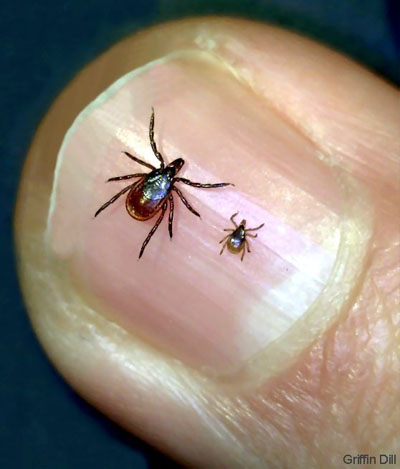Deer Ticks
By Pat Dickey, Fairfax Master Gardener

Adult and nymph
Media reports have been warning us that 2021 could be another bad year for deer ticks. Our winter was exceptionally mild and our spring rainy, both contributing to their larger population. Here is some information on how to identify the different types of ticks and ways to prevent them from harming you.
What are we looking for?
The deer tick (Ixodes scapularis) is the most prevalent type of tick in Fairfax County and the one that can transmit Lyme disease. A deer tick is brown and reddish when fed, with black legs. It has three feeding stages: larva, nymph and adult, and its life cycle can last for two years. Each of these stages feeds on, or bites, a different host, usually mice, deer or rabbits. Ticks ingest the bacterium for Lyme disease (Borrelia burgdorferi) from feeding on these small, infected mammals. We humans have become accidental hosts in this tick’s life cycle.
Most humans become infected from nymphs, when they are active in late spring and summer. Nymphs are about 1 to 2 mm long, about the size of a pin, and have eight legs. Deer ticks wait on the tips of tall weeds and grasses for a mammal host to brush up against them. Contrary to popular belief, ticks cannot fly or jump. After feeding on a host, a tick is filled with blood and drops from the host into a protected place. There it molts to the next stage. The adult females produce eggs after their final blood meal. Adult females can be 10 mm long after feeding.
How do we keep them away?
Prevention is the best way to keep these ticks from infecting you. Deer ticks thrive in humid and moist conditions. favoring dense areas with tall grasses and vegetation. Therefore, it is important to keep your lawn mowed. Rake up and remove moist leaf litter. Prune and remove brush on your property to allow for more sunlight and to reduce humidity. Experts suggest creating a 3-foot wide barrier of wood chips or gravel in areas adjacent to woods as additional protection. Do not try to treat large areas for ticks, since they tend to be concentrated in small areas. See the VA Pest Management Guide about spraying outside of your house for ticks.
An increase in the deer population in our suburban neighborhoods has brought more deer ticks closer to our homes. If deer are attracted to your yard, they will come in large numbers. Bird feeders are very attractive to deer, especially when seed is spilled onto the grass, so try to keep these areas clean. Plant perennials and shrubs that deer will not eat. Create physical barriers to keep deer away or use devices to frighten them.
Recent news stories have reported incidents when mice brought deer ticks inside of homes. Individuals had not been outdoors but still experienced tick bites. Up to 90 percent of white-footed mice also carry the bacterium for Lyme disease. Be sure to check areas where mice can enter your home, such as in garages and in walls under sinks, and plug openings as needed.
You should check for ticks frequently, especially on children and pets. If you plan to be in wooded areas, apply tick repellent with 30 percent DEET on exposed skin and clothing. When walking on trails, stay in the center and avoid brushing up against tall weeds and grass. You may also want to wear long pants to help keep ticks away and light-colored clothing so that the ticks are easier to spot.
What should we do if we find a tick?
Fortunately for us, deer ticks are slow eaters, giving us 24 to 36 hours to remove them before we can become infected. They are most attracted to hard-to-see, moist areas, such as the groin, armpits and scalp. It is best to shower within an hour after being outdoors where you may have come in contact with ticks, in order to keep them from latching on to you. You will not feel when a tick bites you because it first desensitizes the area.

2015 Blacklegged tick distribution. Red=current range, blue=reported
To remove a tick, use fine point tweezers to grasp the tick as close to the skin as you can. Be sure to pull the tick straight out and avoid twisting it, which may release more germs into your wound. If you don’t have tweezers, wrap the tick in tissue and pull it straight out with your fingers. Afterwards, wash your hands and clean the area with antiseptic. If you want to identify it, place it in a plastic bag and bring it to the county Health Department.
A reaction from a tick bite does not occur immediately, but the tell-tale bull’s eye-shaped rash on your skin is a sign that medical treatment is necessary. Do not delay in going to your doctor, because if the tick carried Lyme disease, you can suffer joint, muscle, heart and nerve problems if left untreated. Several years ago, I was bit by a deer tick and had no idea that it occurred until I saw the bull’s eye rash on my arm. Luckily, after the antibiotic treatment that I had, I did not contract Lyme disease.
References
• Ticks, Insects in Recreation Areas, 2021 VA Pest Management Guide, p. 6-4.
• Common Ticks of Virginia, Eric R. Day, Virginia Cooperative Extension
• Your Field Guide to Battle Ticks, Fairfax County Government
• Ticks, Centers for Disease Control and Prevention
• Lyme Disease and Other Diseases Spread by Ticks, Division of Environmental Health, Fairfax County
• Deer: A Garden Pest, Virginia Cooperative Extension
…updated 2021